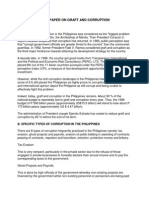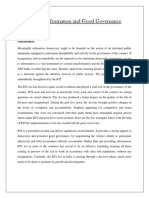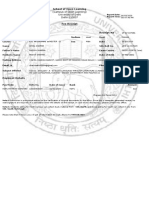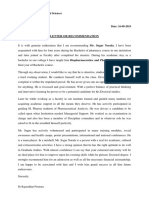0 ratings0% found this document useful (0 votes)
18 viewsReport 1 Content
Report 1 Content
Uploaded by
Ia HernandezThe document discusses the challenges citizens faced in the Philippines in the 2000s when interacting with government departments and agencies. It took Filipinos at least 48 days on average to start a business due to complicated bureaucratic procedures. As a result, many citizens sought illegal means like bribery to expedite the process. This corruption was considered routine and undermined government revenue collection and citizen trust in government. Later campaigns aimed to curb corruption and raise awareness of initiatives under the Anti-Red Tape Act, but public awareness of these efforts remained a challenge.
Copyright:
© All Rights Reserved
Available Formats
Download as DOCX, PDF, TXT or read online from Scribd
Report 1 Content
Report 1 Content
Uploaded by
Ia Hernandez0 ratings0% found this document useful (0 votes)
18 views1 pageThe document discusses the challenges citizens faced in the Philippines in the 2000s when interacting with government departments and agencies. It took Filipinos at least 48 days on average to start a business due to complicated bureaucratic procedures. As a result, many citizens sought illegal means like bribery to expedite the process. This corruption was considered routine and undermined government revenue collection and citizen trust in government. Later campaigns aimed to curb corruption and raise awareness of initiatives under the Anti-Red Tape Act, but public awareness of these efforts remained a challenge.
Original Title
Report_1_content
Copyright
© © All Rights Reserved
Available Formats
DOCX, PDF, TXT or read online from Scribd
Share this document
Did you find this document useful?
Is this content inappropriate?
The document discusses the challenges citizens faced in the Philippines in the 2000s when interacting with government departments and agencies. It took Filipinos at least 48 days on average to start a business due to complicated bureaucratic procedures. As a result, many citizens sought illegal means like bribery to expedite the process. This corruption was considered routine and undermined government revenue collection and citizen trust in government. Later campaigns aimed to curb corruption and raise awareness of initiatives under the Anti-Red Tape Act, but public awareness of these efforts remained a challenge.
Copyright:
© All Rights Reserved
Available Formats
Download as DOCX, PDF, TXT or read online from Scribd
Download as docx, pdf, or txt
0 ratings0% found this document useful (0 votes)
18 views1 pageReport 1 Content
Report 1 Content
Uploaded by
Ia HernandezThe document discusses the challenges citizens faced in the Philippines in the 2000s when interacting with government departments and agencies. It took Filipinos at least 48 days on average to start a business due to complicated bureaucratic procedures. As a result, many citizens sought illegal means like bribery to expedite the process. This corruption was considered routine and undermined government revenue collection and citizen trust in government. Later campaigns aimed to curb corruption and raise awareness of initiatives under the Anti-Red Tape Act, but public awareness of these efforts remained a challenge.
Copyright:
© All Rights Reserved
Available Formats
Download as DOCX, PDF, TXT or read online from Scribd
Download as docx, pdf, or txt
You are on page 1of 1
The challenge
In the 2000s, citizens in the Philippines have
faced significant difficulties in receiving prompt and
efficient service from government departments and
agencies. For example, in order to start a business
Filipinos had to complete 11 individual procedures
and wait for at least 48 days for governmental
approval. This excluded the application for a
business permit at the local mayor’s office and
waiting for designated print shops to issue receipts,
which added even more time. As a result, in
its Doing Business 2007 report the World Bank
ranked the Philippines 126th out of 175 countries
for its "ease of doing business".[1] These long
waiting times and complicated bureaucratic
procedures were common to all the ministries that
provided services to citizens, from supplying
business permits to issuing driving licences.
Given these complex procedures, many citizens
sought illegal, corrupt ways to speed up the process.
Public servants were used to bribes, and they
routinely demanded them: “many of the people who
used frontline services – and the officials who
delivered them – considered bribery and
inefficiency routine”.[2] It was common to hire so-
called "fixers", who made special arrangements to
speed up transactions in exchange for a fee. This, in
turn, meant that the government was unable to
collect adequate revenue for the provision of its
services, while citizens became increasingly
disillusioned with the amount of red tape they
encountered.
Public Confidence Fair
Filipinos were used to a “red-tape culture"
in government services, and it was hard to change
these deep-rooted perceptions. “Here, corrupt acts
facilitate the daily transactions between citizens and
institutions, providing a survival mechanism which
serves as a palliative to the myriad inconveniences
produced by public bureaucracies.”[15]
The Philippines' "social weather station survey" of
December 2007 measured public opinion on
"eradicating graft and corruption" after the first six
months of ARTA. It found that 55 percent of the
population were dissatisfied with the government's
anti-corruption measures immediately after the
enactment of ARTA.[16] However, by 2010 the
public’s support for the anti-corruption strategy had
increased, in the wake of the election of Benigno
Aquino III
In 2009, the OMB and the CSC ran a campaign
against "fixers" and the activity of fixing, “an act
that involves undue facilitation of transactions for
pecuniary gain or any other advantage”.[17] This
campaign called on all government agencies to set
up anti-fixer posters in their entrance and distribute
"anti-fixer calling cards" to their clients, informing
them how to contact the CSC and the OMB in case
they were approached by fixers.
However, the CSC struggled to connect with the
public and raise awareness of ARTA and its
initiatives such as the Citizen's Charter. As such, it
was recommended by a study reviewing the
implementation of the Charter in 2012 that public
awareness needed to be raised.
You might also like
- Issues and Problems in Public Fiscal AdministrationDocument2 pagesIssues and Problems in Public Fiscal AdministrationYeah Seen Bato Berua89% (45)
- The Reading LessonDocument53 pagesThe Reading LessonNicole Schaben62% (13)
- A Research Paper Anti Red Tape ActDocument18 pagesA Research Paper Anti Red Tape ActMara Cojamco50% (2)
- National Id SystemDocument21 pagesNational Id SystemAirene CastañosNo ratings yet
- ARTA RESEARCH THESIS Chapter 1Document15 pagesARTA RESEARCH THESIS Chapter 1Dara Rom100% (1)
- First Draft Foun 1013 Documented EssayDocument7 pagesFirst Draft Foun 1013 Documented EssayTiffany DunkleyNo ratings yet
- ASEAN Conference On Promoting Social Accountability in Public ServiceDocument22 pagesASEAN Conference On Promoting Social Accountability in Public Serviceaccsm_cscNo ratings yet
- FINAL CASE DIGEST - HernandezDocument71 pagesFINAL CASE DIGEST - HernandezIa HernandezNo ratings yet
- Report 1 ContentDocument1 pageReport 1 ContentNat HernandezNo ratings yet
- The Anti-Red Tape Act in The PhilippinesDocument3 pagesThe Anti-Red Tape Act in The PhilippinesMimiNo ratings yet
- Written Report. Introduction 1.c. Anti-Red Tape Act of 2007 (RA 9485) Ease of Doing Business and Efficient Government Service Delivery Act of 2007Document5 pagesWritten Report. Introduction 1.c. Anti-Red Tape Act of 2007 (RA 9485) Ease of Doing Business and Efficient Government Service Delivery Act of 2007Zaldy Roman MendozaNo ratings yet
- Article ReviewDocument9 pagesArticle ReviewJessica PoligNo ratings yet
- Notes in Strategies For Preventing and Addressing CorruptionDocument11 pagesNotes in Strategies For Preventing and Addressing Corruptionprincess julie ann bayogosNo ratings yet
- Philippines ArtaDocument4 pagesPhilippines ArtaHydon Biñas LibradillaNo ratings yet
- Graft and CorruptionDocument53 pagesGraft and CorruptionKring Kring K. Kringers100% (4)
- Reducing Red Tape in GovernmentDocument16 pagesReducing Red Tape in GovernmentStratbase ADR Institute100% (1)
- Graft and CorruptionDocument29 pagesGraft and CorruptionSALVADOR JhemaicaNo ratings yet
- Graft and CorruptionDocument36 pagesGraft and CorruptionCHOSEN TABANASNo ratings yet
- Kenneth C. Ferrer: University of Rizal SystemDocument7 pagesKenneth C. Ferrer: University of Rizal SystemKarlo Dimitrije DerevkoNo ratings yet
- 100 Days of PNoyDocument45 pages100 Days of PNoymis_administratorNo ratings yet
- Issues and Concerns in The Philippines and Areas FDocument15 pagesIssues and Concerns in The Philippines and Areas FIvy EspadillaNo ratings yet
- Benefits of Proactive Information DisclosureDocument2 pagesBenefits of Proactive Information DisclosureMohammad Shahjahan SiddiquiNo ratings yet
- The Quality of Public Services in The Philippines Villamejor MendozaDocument28 pagesThe Quality of Public Services in The Philippines Villamejor Mendozaopa.pmsdNo ratings yet
- Graft and CorruptionDocument8 pagesGraft and CorruptionCesar FranciscoNo ratings yet
- Who Let The Ghosts Out?: Article X1, Section 1 of The 1987 ConstitutionDocument3 pagesWho Let The Ghosts Out?: Article X1, Section 1 of The 1987 ConstitutionJP Ramos DatinguinooNo ratings yet
- Case Study & ReflectionDocument4 pagesCase Study & ReflectionBernadette Ruth MasuliNo ratings yet
- Public Sector: Ccountability in OvernanceDocument3 pagesPublic Sector: Ccountability in OvernanceAnjo PadillaNo ratings yet
- Privatization As Engine of Growth in The PhilippinesDocument21 pagesPrivatization As Engine of Growth in The PhilippinesDAUL GINA MAYNo ratings yet
- EconDocument3 pagesEconninenrqzNo ratings yet
- Graft and Corruption: Philippine Social Realities and Social WelfareDocument23 pagesGraft and Corruption: Philippine Social Realities and Social WelfareSandra ManansalaNo ratings yet
- Local Literature Choy SexyDocument10 pagesLocal Literature Choy Sexyjej heNo ratings yet
- Guinto, Critique PaperDocument4 pagesGuinto, Critique PaperReanne GuintoNo ratings yet
- Underlying Problems of Philippine Public AdministrationDocument8 pagesUnderlying Problems of Philippine Public AdministrationChristopher IgnacioNo ratings yet
- The Correct™ Movement Website PDF File: Graft and Corruption: The Philippine ExperienceDocument11 pagesThe Correct™ Movement Website PDF File: Graft and Corruption: The Philippine ExperiencePatrick UyNo ratings yet
- A Social Evil: EditorialDocument10 pagesA Social Evil: EditorialDaisuke InoueNo ratings yet
- The Quality of Public Services in The Philippines Villamejor MendozaDocument23 pagesThe Quality of Public Services in The Philippines Villamejor MendozaphiongskiNo ratings yet
- PDAF - How The Pork Butchered Philippines' Politics - A Case Study AnaysisDocument10 pagesPDAF - How The Pork Butchered Philippines' Politics - A Case Study AnaysisKeith CensoroNo ratings yet
- Gabriel2018 ReferenceWorkEntry BureaucraticRedTapeInThePhilipDocument10 pagesGabriel2018 ReferenceWorkEntry BureaucraticRedTapeInThePhilipAnaliza V. MuñozNo ratings yet
- A Case Study On Should The Philippines Adopt A National IDocument8 pagesA Case Study On Should The Philippines Adopt A National IJoyce RamirezNo ratings yet
- View As A WholeDocument3 pagesView As A WholeJ Bajar AbordoNo ratings yet
- Research Assignment On The Extent of E-Government Implementation in The PhilippinesDocument19 pagesResearch Assignment On The Extent of E-Government Implementation in The PhilippinesMa YaNo ratings yet
- Underlying Problems of Philippine Public Administration 1Document2 pagesUnderlying Problems of Philippine Public Administration 1Umbina GesceryNo ratings yet
- Notes - RIGHT TO INFORMATIONDocument10 pagesNotes - RIGHT TO INFORMATIONG ThNo ratings yet
- SB 1995: Reforming Electoral Campaign: By: Deborah B. PalacioDocument4 pagesSB 1995: Reforming Electoral Campaign: By: Deborah B. PalacioDeborah PalacioNo ratings yet
- Philippine Civil Service System Evaluative EssayDocument3 pagesPhilippine Civil Service System Evaluative EssayMaristelle CarreonNo ratings yet
- Module 6 - Graft and CorruptionDocument4 pagesModule 6 - Graft and Corruptionjessafesalazar100% (1)
- Araling Panlipunan 10 Sir Arnel Quilang: A Powerpoint Presentation by Jacob TolentinoDocument20 pagesAraling Panlipunan 10 Sir Arnel Quilang: A Powerpoint Presentation by Jacob TolentinoJacob Tolentino100% (1)
- Graft and Corruption: The Philippines' Unbeatable FoeDocument14 pagesGraft and Corruption: The Philippines' Unbeatable Foemassy_blue03No ratings yet
- Corruption in The PhilippinesDocument4 pagesCorruption in The PhilippinesCarson GarazaNo ratings yet
- Reflection 3 - Campos, Grace R.Document4 pagesReflection 3 - Campos, Grace R.Grace Revilla CamposNo ratings yet
- Legitimacy and Voice Synthesize JunatherDocument4 pagesLegitimacy and Voice Synthesize JunatherGracelyn Kaye AlfanteNo ratings yet
- MALAPOTE VIA MARIA I. Final Output Transaparency and AccountabilityDocument21 pagesMALAPOTE VIA MARIA I. Final Output Transaparency and AccountabilityVia Maria MalapoteNo ratings yet
- Right To Information and Good Governance: AbstractDocument20 pagesRight To Information and Good Governance: Abstractmayank shekharNo ratings yet
- Pahamtang, Rip Van Winkle J.Document9 pagesPahamtang, Rip Van Winkle J.Odlanyer ParkerNo ratings yet
- Graft & Corruption in The GovernmentDocument19 pagesGraft & Corruption in The GovernmentNi CaNo ratings yet
- 07 BARBOSA ENT3107 Microfinancing FINALS - 13 Jan 2024Document13 pages07 BARBOSA ENT3107 Microfinancing FINALS - 13 Jan 2024sheenabarbosa09No ratings yet
- Practicability Law DebateDocument2 pagesPracticability Law DebateRogie ToriagaNo ratings yet
- The Correct™ Movement Website PDF File: Graft and Corruption: The Philippine ExperienceDocument13 pagesThe Correct™ Movement Website PDF File: Graft and Corruption: The Philippine ExperiencePatrick UyNo ratings yet
- Bribery in BusinessDocument7 pagesBribery in BusinessJohn KiranNo ratings yet
- Corruption in the Nigerian Public Service Nipping It in the BudFrom EverandCorruption in the Nigerian Public Service Nipping It in the BudNo ratings yet
- Duterte's Legacy: The Ten Pillars of ProgressFrom EverandDuterte's Legacy: The Ten Pillars of ProgressRating: 5 out of 5 stars5/5 (1)
- Cristina Miguela V. Villalva - ARELLANO UNIVERSITY SCHOOL OF LAWDocument26 pagesCristina Miguela V. Villalva - ARELLANO UNIVERSITY SCHOOL OF LAWIa HernandezNo ratings yet
- Ramon Gonzales v. Go Tiong Case DigestDocument2 pagesRamon Gonzales v. Go Tiong Case DigestIa HernandezNo ratings yet
- Special Power of Attorney: Principal Attorney-In-FactDocument2 pagesSpecial Power of Attorney: Principal Attorney-In-FactIa HernandezNo ratings yet
- Special Power of Attorney: Principal Attorney-in-FactDocument2 pagesSpecial Power of Attorney: Principal Attorney-in-FactIa HernandezNo ratings yet
- Talengtan Bros. & Sons vs. CA, G.R. No. L-110581, Sept. 21, 1994Document6 pagesTalengtan Bros. & Sons vs. CA, G.R. No. L-110581, Sept. 21, 1994Ia HernandezNo ratings yet
- Special Laws - 0915Document6 pagesSpecial Laws - 0915Ia HernandezNo ratings yet
- Ss MiningDocument18 pagesSs MiningIa HernandezNo ratings yet
- Midterms LectureDocument4 pagesMidterms LectureIa HernandezNo ratings yet
- Property Midterms NCHDocument10 pagesProperty Midterms NCHIa HernandezNo ratings yet
- Insurance 1st Recit Meeting DigestsDocument20 pagesInsurance 1st Recit Meeting DigestsIa HernandezNo ratings yet
- Leandro Carillo Vs People of The Philippines G.R. No. 86890, January 21, 1994Document214 pagesLeandro Carillo Vs People of The Philippines G.R. No. 86890, January 21, 1994Ia HernandezNo ratings yet
- PROPERTY Lecture01Document10 pagesPROPERTY Lecture01Ia HernandezNo ratings yet
- Legal Ethics 0320Document9 pagesLegal Ethics 0320Ia HernandezNo ratings yet
- Commissioner's Report & RecommendationDocument46 pagesCommissioner's Report & RecommendationIa HernandezNo ratings yet
- Legal Ethics Cases Jan 16Document60 pagesLegal Ethics Cases Jan 16Ia HernandezNo ratings yet
- Title V. Crimes Relative To Opium and Other Prohibited DrugsDocument36 pagesTitle V. Crimes Relative To Opium and Other Prohibited DrugsIa HernandezNo ratings yet
- Be It Enacted by The Senate and The House of Representatives of The Philippines in Congress AssembledDocument3 pagesBe It Enacted by The Senate and The House of Representatives of The Philippines in Congress AssembledIa HernandezNo ratings yet
- Courts. Judicial Proceedings For The Registration of Lands Throughout TheDocument48 pagesCourts. Judicial Proceedings For The Registration of Lands Throughout TheIa HernandezNo ratings yet
- Title III. Crimes Against Public Order Chapter I. Rebellion, Coup D'Etat, Sedition and Disloyalty Article 134 - /insurrectionDocument28 pagesTitle III. Crimes Against Public Order Chapter I. Rebellion, Coup D'Etat, Sedition and Disloyalty Article 134 - /insurrectionIa HernandezNo ratings yet
- Title I: Crimes Against National Security & The Laws of NationsDocument122 pagesTitle I: Crimes Against National Security & The Laws of NationsIa HernandezNo ratings yet
- What Have We Learned About The Topic?Document14 pagesWhat Have We Learned About The Topic?Ia HernandezNo ratings yet
- Search - Freedom of Speech PDFDocument236 pagesSearch - Freedom of Speech PDFIa HernandezNo ratings yet
- Labor2 - Special Laws 1Document3 pagesLabor2 - Special Laws 1Ia HernandezNo ratings yet
- PH Bill 1902Document18 pagesPH Bill 1902Ia HernandezNo ratings yet
- Act No 926Document6 pagesAct No 926Ia HernandezNo ratings yet
- Primary Holding: AnnotationDocument11 pagesPrimary Holding: AnnotationIa HernandezNo ratings yet
- Novation LectureDocument4 pagesNovation LectureIa HernandezNo ratings yet
- Committee Year Purpose Recommendations: Latest Version On 1Document7 pagesCommittee Year Purpose Recommendations: Latest Version On 1Aditi SaxenaNo ratings yet
- Bill of Lading: Bar Code SpaceDocument2 pagesBill of Lading: Bar Code SpaceAIR RIFLE EKSPERIMENNo ratings yet
- E CommerceDocument10 pagesE CommerceShubham KumarNo ratings yet
- MGRP Housing Final Report PDFDocument45 pagesMGRP Housing Final Report PDFThird EsperoNo ratings yet
- Kemahiran Komunikasi Untuk Profesional MuslimDocument12 pagesKemahiran Komunikasi Untuk Profesional MuslimSyarifah NourazlinNo ratings yet
- CB9 Story Ave Proposal ResponseDocument2 pagesCB9 Story Ave Proposal ResponseGersh KuntzmanNo ratings yet
- 4 PlanningDocument3 pages4 Planningnaeem_whdNo ratings yet
- Engagement & Wellbeing: Lake Boga Primary School 3278Document17 pagesEngagement & Wellbeing: Lake Boga Primary School 3278DISHONNo ratings yet
- In The High Court of South Africa Gauteng Local Division, JohannesburgDocument9 pagesIn The High Court of South Africa Gauteng Local Division, JohannesburgColias DubeNo ratings yet
- Vodacom Lesotho Bursary Application Form FinalDocument5 pagesVodacom Lesotho Bursary Application Form FinalSechaba QathatsiNo ratings yet
- Assignment 01 CC-0695Document11 pagesAssignment 01 CC-0695Ghazal MunirNo ratings yet
- Cross Selling Process in SAPDocument15 pagesCross Selling Process in SAPRomar Jose Duran ZanottyNo ratings yet
- Correction and Remediation of ErrorsDocument4 pagesCorrection and Remediation of Errorsrebat100% (2)
- Business Ansoff MatrixDocument2 pagesBusiness Ansoff MatrixKeziaNo ratings yet
- Mehedi Hasan Rabby: Cell: 01861-819926Document2 pagesMehedi Hasan Rabby: Cell: 01861-819926Tushar SHekNo ratings yet
- Thesis SourcesDocument4 pagesThesis SourcesPraise Rafols PasajeNo ratings yet
- Aksyon Risert DO2 NavotasDocument135 pagesAksyon Risert DO2 Navotasmarco medurandaNo ratings yet
- Explain Briefly Non-Tariff Measures and Give Three Examples?Document8 pagesExplain Briefly Non-Tariff Measures and Give Three Examples?Meysam KhamehchiNo ratings yet
- (Campus of Open Learning) University of Delhi Delhi-110007Document1 page(Campus of Open Learning) University of Delhi Delhi-110007Smriti SharmaNo ratings yet
- Commercial Analysis Final DraftDocument5 pagesCommercial Analysis Final Draftapi-491074972No ratings yet
- SANKALP-Chirang REPORTDocument19 pagesSANKALP-Chirang REPORTsubhankar mazumderNo ratings yet
- Rajasekhar SirDocument1 pageRajasekhar SirYuppie RajNo ratings yet
- HỢP ĐỒNG THANH TOÁN QUỐC TẾDocument4 pagesHỢP ĐỒNG THANH TOÁN QUỐC TẾTrần HoaNo ratings yet
- The Title (Type The Title of Your Research Article)Document2 pagesThe Title (Type The Title of Your Research Article)Jun ArtaNo ratings yet
- Learning Task 5 Evero CarinapassDocument23 pagesLearning Task 5 Evero CarinapassPlatero Roland100% (1)
- Concept Paper Is A Short SummaryDocument3 pagesConcept Paper Is A Short SummaryRealyn ZambasNo ratings yet
- GBI Design Reference Guide - Non-Residential Existing Building (NREB) V1.01Document70 pagesGBI Design Reference Guide - Non-Residential Existing Building (NREB) V1.01sharvinNo ratings yet
- Mayank Yadav: Academic QualificationDocument2 pagesMayank Yadav: Academic QualificationJacob PruittNo ratings yet
- The Beginnings of FDI in E-CommerceDocument16 pagesThe Beginnings of FDI in E-CommerceAbhinavNo ratings yet





















































































































